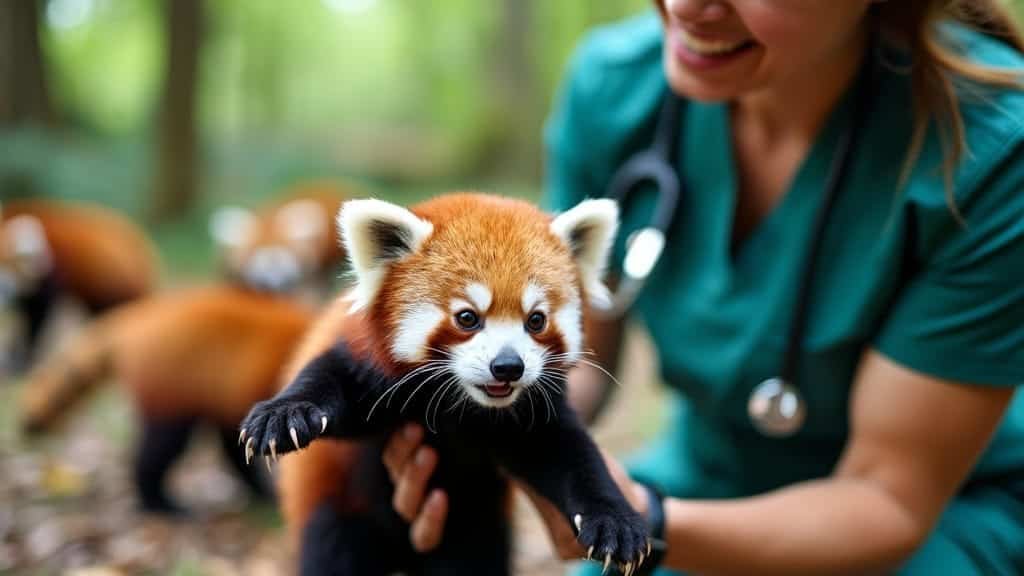Introduction
Sanctuaries play a critical role in the rehabilitation of injured or orphaned red pandas, providing the medical care and safe environments needed for recovery
These sanctuaries not only address the physical needs of red pandas but also help prepare them for eventual reintroduction into the wild, where they can thrive once again. From specialized medical treatments to creating naturalistic habitats that promote healing, sanctuaries are vital in ensuring the survival of this endangered species
In this article, we will explore the types of care sanctuaries provide, how they rehabilitate red pandas, and the challenges they face in their conservation efforts
Medical Care for Injured and Orphaned Red Pandas
Wildlife sanctuaries are crucial in providing medical care to injured or orphaned red pandas. Whether these pandas are found injured due to accidents, habitat destruction, or poaching, sanctuaries are equipped to treat a wide range of injuries and illnesses
Additionally, orphaned red pandas, which face unique challenges for survival, are given specialized care to ensure they can grow and develop in a safe environment. These facilities act as lifelines for red pandas that would otherwise struggle to survive in the wild
Common Injuries and Medical Conditions Treated
Sanctuaries often treat red pandas suffering from a variety of injuries, particularly those caused by habitat encroachment and human-related activities. Common injuries include fractures from falls or vehicle collisions, cuts from traps or sharp objects, and malnutrition due to habitat degradation
In regions where poaching is still a threat, red pandas may also be found with wounds from traps or snares. Additionally, red pandas are vulnerable to diseases such as respiratory infections and parasites, which can further threaten their already fragile populations
Sanctuaries, with their veterinary teams, provide immediate medical attention, such as surgeries to repair broken bones, treatments for infections, and proper nutrition plans to restore their health
For example, the Padmaja Naidu Himalayan Zoological Park in India, a facility that specializes in red panda care, has successfully treated pandas for trauma-related injuries and malnutrition. The goal is to stabilize the pandas’ condition so they can begin the recovery process
Veterinary Care and Recovery Procedures
Veterinarians in sanctuaries play a vital role in ensuring red pandas receive the necessary medical interventions. These specialists conduct thorough examinations upon the panda’s arrival, assessing their physical condition and diagnosing any underlying health issues
Common treatments include surgeries, splinting for fractures, and antibiotic therapy for infections. In some cases, red pandas may require long-term care if their injuries are severe or if they suffer from chronic health problems
Once the initial medical care is provided, sanctuaries focus on the recovery phase. This includes carefully monitored rehabilitation programs where pandas are given a safe environment to regain their strength
This phase may involve physical therapy, ensuring the pandas regain mobility after injuries, and nutritional support to help them recover from malnourishment or digestive issues. The staff regularly monitors their progress and adjusts treatment plans as needed
Specialized Rehabilitation for Orphaned Red Pandas
Orphaned red pandas, particularly young cubs, face unique challenges in rehabilitation. Without their mothers, these cubs need intensive care to survive
Sanctuaries provide round-the-clock attention to orphaned red pandas, ensuring they receive proper nutrition and socialization to mimic the learning experiences they would have had with their mother. This includes bottle-feeding in the early stages of life and gradually introducing them to solid foods, such as bamboo, as they grow older
Orphaned red pandas are also taught essential survival skills within the sanctuary. Caretakers help them develop the climbing and foraging abilities they will need once they are reintroduced into the wild
Additionally, these young pandas are often housed in special enclosures that mimic natural habitats, providing a safe space for them to explore and practice behaviors critical to their survival
Sanctuaries like the Red Panda Network’s field stations are dedicated to caring for these vulnerable cubs, ensuring that they are given every opportunity to grow and thrive
Rehabilitation and Reintroduction Programs
Sanctuaries play a key role not only in treating injured or orphaned red pandas but also in rehabilitating them for eventual release back into the wild
Once the pandas have recovered from their injuries or reached an age where they can survive independently, the focus shifts toward preparing them for life outside the sanctuary. This process involves gradually reintroducing red pandas to their natural behaviors, ensuring they are equipped with the skills they need to thrive in the wild
Preparing Red Pandas for Life in the Wild
The goal of any red panda rehabilitation program is to eventually return the animals to their natural habitat. To do this successfully, sanctuaries work to ensure that the pandas are physically and mentally ready for the challenges of living in the wild
This involves simulating natural environments within the sanctuary where the pandas can practice essential behaviors such as climbing, foraging, and avoiding predators
Sanctuaries also carefully control the amount of human interaction red pandas receive during this phase to prevent them from becoming overly dependent on humans. The less habituated red pandas are to human presence, the better their chances of surviving in the wild
Before release, pandas are often fitted with tracking collars to monitor their movements and ensure they are adapting well to their new environment. This data allows sanctuary staff to make informed decisions about the success of the reintroduction and to intervene if necessary
Monitoring Red Pandas Post-Rehabilitation
Once red pandas are released into the wild, the sanctuary’s work does not end. Post-release monitoring is a critical component of the reintroduction process. Using GPS collars or radio telemetry, sanctuary staff and conservationists track the movements, behavior, and health of the pandas to ensure they are adjusting to life in the wild. This monitoring phase can last several months to over a year, depending on the individual panda’s progress
The data collected during this period helps conservationists evaluate the success of the reintroduction program. They can assess whether the pandas are finding adequate food, avoiding human-populated areas, and establishing territories
If a panda shows signs of struggling—such as malnutrition or difficulty adapting to the wild—it may be recaptured and brought back to the sanctuary for further care. This ongoing support is essential for ensuring that reintroduced pandas can survive and thrive long-term
Challenges in Reintroduction Efforts
Despite the best efforts of sanctuaries, reintroducing red pandas into the wild presents significant challenges. One of the primary obstacles is habitat loss due to deforestation and human encroachment
Even after a successful rehabilitation, red pandas may struggle to find safe and sufficient habitats where they can avoid human conflict and access enough food, particularly bamboo, which makes up the majority of their diet
Another challenge is ensuring that red pandas, especially those raised in sanctuaries from a young age, can properly adapt to the wild. While sanctuaries work hard to mimic natural conditions, nothing fully replicates the experience of living in the wild
Some pandas may lack the survival instincts or social behaviors that wild-born pandas naturally acquire, making it harder for them to establish territories and interact with other pandas. Additionally, the stress of reintroduction can sometimes lead to health complications or difficulties in adjusting, requiring careful and continuous management
Despite these challenges, sanctuaries continue to refine their rehabilitation and reintroduction strategies, drawing on both scientific research and field experience. Through collaboration with conservation groups and local communities, they aim to give red pandas the best possible chance of survival in the wild
Sanctuary Habitats and Public Education
In addition to providing medical care and rehabilitation, sanctuaries play a crucial role in creating naturalistic habitats for red pandas and educating the public about conservation. Sanctuaries not only replicate the pandas’ natural environment to aid in their recovery but also use these spaces to raise awareness about the challenges red pandas face in the wild
Public engagement is an important component of conservation efforts, and sanctuaries leverage educational programs to inspire visitors to support wildlife protection and environmental sustainability
Creating Naturalistic Habitats for Red Pandas
Sanctuaries aim to recreate environments that closely resemble the red panda’s natural habitat to help facilitate their recovery and rehabilitation
These enclosures are designed with ample trees, bamboo plants, and climbing structures that allow pandas to exercise their natural behaviors, such as climbing, foraging, and resting in elevated spaces
By creating enclosures that mimic the temperate forests of the eastern Himalayas, sanctuaries enable red pandas to develop essential survival skills that they will need upon reintroduction to the wild
The physical design of these habitats is critical to the pandas’ mental and physical well-being. Red pandas are solitary and territorial animals, so sanctuaries typically offer spacious enclosures that allow them to establish their own space. Enrichment activities, such as hiding food or creating puzzles, encourage natural foraging behaviors, keeping the pandas active and mentally stimulated
In this way, sanctuaries ensure that red pandas maintain a level of fitness and adaptability that will be crucial for their survival after release
Educational Programs for Visitors and Communities
One of the key functions of sanctuaries is to educate the public about the plight of endangered species like the red panda
Many sanctuaries offer guided tours, workshops, and interactive exhibits that teach visitors about red pandas, their habitats, and the broader conservation challenges they face. These educational programs aim to inspire empathy and a sense of responsibility toward wildlife protection, encouraging visitors to take part in conservation efforts
Sanctuaries often partner with schools and local community groups to provide educational outreach, offering programs that align with environmental education curriculums. Students can participate in hands-on activities, such as habitat restoration projects or virtual learning sessions, where they observe the care of red pandas in real-time
These programs help foster a deeper understanding of the importance of biodiversity and the role individuals and communities can play in protecting endangered species
Sanctuaries also promote global conservation awareness through social media and online platforms, offering virtual tours, live streams, and updates on their red panda rehabilitation efforts. By engaging with a global audience, they raise awareness about the threats facing red pandas and encourage people from around the world to contribute to conservation initiatives
The Role of Sanctuaries in Red Panda Conservation
Sanctuaries are more than just places for temporary care—they are vital centers for long-term conservation
In addition to rehabilitating injured or orphaned red pandas, sanctuaries often collaborate with conservation organizations to contribute to broader efforts aimed at protecting red panda populations. This includes participating in research on red panda behavior, genetics, and habitat use, which informs conservation strategies across the species’ range
Sanctuaries also work closely with local governments and international wildlife groups to advocate for policies that protect red panda habitats and reduce the threats of poaching and deforestation. By acting as both caretakers and advocates, sanctuaries play a dual role in preserving not only individual red pandas but also the species as a whole
Through their rehabilitation efforts, habitat creation, and public education programs, sanctuaries ensure that red pandas receive the care they need to survive and that the public remains engaged in the critical mission of conservation
Conclusion
Sanctuaries play an essential role in the rehabilitation and conservation of red pandas, providing critical medical care, safe habitats, and specialized programs for their recovery. From treating injuries and nurturing orphaned pandas to preparing them for reintroduction into the wild, sanctuaries are at the forefront of efforts to protect this endangered species
Beyond direct care, sanctuaries also serve as vital hubs for public education, raising awareness about the challenges red pandas face and encouraging communities to support conservation efforts
Through collaboration with veterinarians, conservationists, and local communities, sanctuaries contribute significantly to the survival and wellbeing of red pandas, ensuring that these iconic animals can thrive both in the wild and in protected environments









